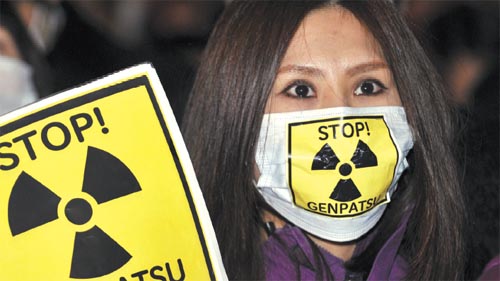Japan being urged to expand evacuation zone

A Japanese civic group member protests yesterday against Tokyo Electric Power Company over leaks at the Fukushima nuclear power plant. [AFP/YONHAP]
Pressure mounted on Japan on Thursday to expand the evacuation zone around its stricken nuclear power plants after high levels of radiation were found outside the zone and radioactivity in seawater reached more than 4,000 times its legal limit.
The U.N. nuclear watchdog suggested Japan consider widening its 20-km (12-mile) zone after high radiation was detected at twice that distance from the facility.
Nearly three weeks after an earthquake and tsunami sparked the world’s worst nuclear crisis since Chernobyl in 1986, Prime Minister Naoto Kan is facing heavy criticism for sticking with the original exclusion zone.
The government has encouraged those living in a 20-30 kilometer (12-18 mile) ring, a population of 136,000, to leave but has not ordered them to do so, advising only that they remain indoors.
The International Atomic Energy Agency (IAEA) said radiation at Iitate village, 40 kilometers from the crippled Fukushima Daiichi nuclear plant, exceeded a criterion for evacuation.
Japan’s nuclear safety agency said an extension of the zone should be considered, but Chief Cabinet Secretary Yukio Edano gave no indication the government was poised to do it.
“At the moment, we have no reason to think that the radiation will have an effect on people’s health. We need to closely monitor the situation and see if the radiation is consistently high,” Edano said at a news briefing.
The safety agency said the radioactive iodine level found in seawater near the damaged plant was now 4,385 times more than the legal limit - the highest level recorded since the nuclear crisis started on March 11 - and it was possible that radiation was flowing continuously into the ocean.
French President Nicolas Sarkozy was due to arrive on Thursday, the first leader to visit since the devastating earthquake and tsunami. Sarkozy, who currently chairs the G-20 and G-8 blocs of nations, is due to meet his Japanese counterpart to show support for Japan’s efforts to overcome the crisis.
France, the world’s most nuclear-dependent country, has flown in experts from state-owned nuclear reactor maker Areva, while the United States has offered robots to help repair the damaged nuclear plant north of Tokyo.
Japan is also facing a humanitarian calamity triggered by the earthquake and tsunami, which left more than 27,500 people dead or missing.
Concerns over radiation spreading beyond Japan grew again after Singapore detected radiation nine times the limit in cabbage imported from Japan, while the United States reported “minuscule” levels of radiation in milk samples on its West Coast.
“These types of findings are to be expected in the coming days and are far below levels of public health concern, including for infants and children,” the Food and Drug Administration and the Environmental Protection Agency said.
Contaminated milk was one of the biggest causes of thyroid cancers after the nuclear accident in Chernobyl because people near the plant kept drinking milk from local cows.
Several countries have banned milk and produce from the areas near the damaged nuclear plant, 240 kilometers north of Tokyo. Japan itself has stopped exports of vegetables and milk from near the plant, which is leaking radiation.
Japan has called on World Trade Organization nations not to impose “unjustifiable” import curbs on its goods due to radiation fears. While food makes up only 1 percent of Japan’s exports, the tsunami-crippled nuclear plant poses a serious risk to an economy burdened with huge public debt and an aging population.
Reuters
한글 관련 기사 [중앙일보]
원전 반경 20㎞ … 일, 출입금지 추진
후쿠시마산 채소서 기준치 68배 세슘
원전 주변 피폭된 시신 1000여구 방치
일본 정부가 후쿠시마 원전 인근 지역에 대한 통제 강화를 추진하고 있다. 교도통신은 지난달 30일 “정부가 제1원전 반경 20㎞ 지역을 출입금지 구역으로 지정하는 방안을 마련하고 있다”며 “대피했던 일부 주민이 귀가하는 일이 종종 발생하고 있기 때문”이라고 보도했다. 또 “이 조치는 후쿠시마현의 요청에 따른 것”이라고 덧붙였다.
현재 일본 정부는 제1원전 반경 20㎞ 지역 주민에게 대피령을 내렸고, 20~30㎞ 지역 주민에게는 대피 권고만 하고 있다. 이런 가운데 국제원자력기구(IAEA)는 “주민 대피 범위를 확대하는 방안을 검토하라”고 일본 정부에 권고했다.
후쿠시마 제1원전에서 북서쪽으로 40㎞ 떨어진 이타테(飯館) 마을의 방사능 수치가 IAEA 대피권고 기준치를 크게 초과했기 때문이다. IAEA는 “이타테 마을의 방사능 수치는 ㎡당 200만 베크렐로 기준치의 두 배에 달한다”고 밝혔다. 지난달 20일에도 이 마을 수돗물에서 기준치의 세 배가 넘는 방사성 요오드가 검출됐다. 데니스 플로리 IAEA 사무차장은 “일본에 현 상황을 면밀히 검토하라고 조언했으며, 일본 정부가 이를 조사 중”이라고 밝혔다.
31일에는 후쿠시마 원전 인근 바닷물에서 법적 기준치의 4385배에 달하는 요오드 131이 검출됐다고 일본 경제산업성 산하 원자력안전·보안원(NISA)이 밝혔다. 이는 이번 원전사고 이후 바닷물에서 검출된 방사선 수치 중 가장 높은 수준이다. 후쿠시마의 토양오염도 심각한 것으로 조사됐다. 후생노동성이 후쿠시마산 채소 43종에 대해 조사한 결과 절반이 넘는 25종에서 기준치를 초과하는 방사성 물질이 검출됐다. 일부 채소에서는 기준치보다 무려 68배 많은 방사성 세슘이 나왔다.
또 정부 자문기구인 원자력안전위원회는 “제1원전 1~3호기에서 연료봉을 보호하는 압력용기가 손상되고 있는 것이 사실인 것 같다”고 밝혔다.
한편 일본 경시청은 원전 반경 20㎞ 지역에 동일본 대지진과 쓰나미 등으로 숨진 사람들의 시신이 방치돼 있다고 밝혔다. 경시청은 “최대 1000구에 달하는 시신을 수습해 유족들에게 인도해야 하지만 이미 방사능에 피폭된 상태여서 처리가 쉽지 않은 상황”이라며 “화장을 할 경우 방사성 물질이 연기로 확산될 우려가 있으며 매장을 해도 토양오염을 일으키기 때문”이라고 밝혔다.










with the Korea JoongAng Daily
To write comments, please log in to one of the accounts.
Standards Board Policy (0/250자)